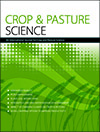Salinity is a major threat to global agriculture due to the loss of productive land and the sensitivity of most crops, limiting the variety of production. Halotolerant plant growth-promoting bacteria show promise for increasing stress tolerance of sensitive crops like chia (Salvia hispanica). This research is the first to evaluate inoculation of soil for chia plants with free-living bacteria of this kind. The bacteria tested improved plant growth and stress tolerance, showing their potential as bioinoculants for crops under salt stress.

Crop & Pasture Science
Volume 75 Number 9 2024
We investigate the role of some genes in betel palm under thermal stress, an increasing problem for the plant’s survival as climate change progresses. This gene family plays a fundamental role in tolerating heat stress. We identified 34 genes, of which eight exhibited enhanced expression under heat stress. The role of this gene family in betel palm’s heat tolerance mechanisms is revealed, providing valuable insights into the plant’s ability to withstand heat stress in a changing climate.
This article belongs to the Collection Abiotic Stress Tolerance vs Climate Change.
Pasture dieback has been affecting the health and productivity of pastures in eastern Queensland and northern NSW. We used aerial imagery to map and compare pasture dieback spread patterns in three land use areas: grazed pasture, ungrazed pasture and rehabilitated pasture following coal mining. The fastest rate of spread was recorded in ungrazed pasture followed by rehabilitation and grazed pastures. Flora surveys showed that dieback-impacted sites shifted from buffel grass to forb dominated pastures.
CP23340 Abstract | CP23340 Full Text | CP23340PDF (4 MB) | CP23340Supplementary Material (2.9 MB) Open Access Article
This study highlights the first greenhouse gas evaluation of Brachiaria BRS Ipyporã (released in 2017) and Mulato II in forage–livestock systems in the Brazilian Amazon. These hybrid forages promise a more sustainable system by reducing greenhouse gas emissions per kilogram of product. These results address the importance of well-managed pastures as a sustainable practice and the use of Brachiaria grass hybrids as an alternative for a more efficient system with reduced emissions per unit of product.
The future of livestock farming is based on forage management practices that balance the use of natural resources and the technical efficiency of forage farming for cattle. Therefore, we investigated the methods of using Panicum maximum cvv. Mombaça and Tanzania forages, and our findings demonstrate that post-grazing residues are the main indicators for adapting grazing management. Managing pasture at heights between ≥31 and ≥39 cm for both cultivars increases cattle performance, a basic strategy for competitiveness in pasture-based livestock farming.




